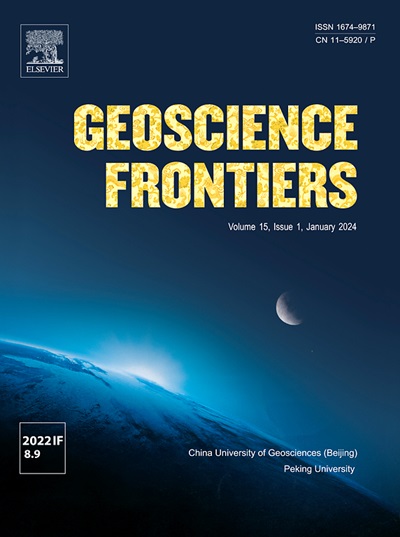Formation of late-stage passive-roof duplexes in fold-and-thrust belts: Thrusting sequence and thermochronologic constraints from the Northern Apennines (Italy)
IF 8.9
1区 地球科学
Q1 GEOSCIENCES, MULTIDISCIPLINARY
引用次数: 0
Abstract
Passive-roof duplexes accommodate shortening at the mountain front of many fold-and-thrust belts worldwide. These structures typically manifest at the surface by hinterland-verging backthrusts that decouple thin-skinned thrust sheets from underlying foreland-verging duplexes. Although the main factors controlling the development of passive-roof duplexes have mostly been identified, some of their intrinsic characteristics are still poorly defined. These relate to their spatio-temporal relationships to thrust faults located further inland in orogens, and their ability to transport younger rocks over older ones. This study explores these issues in the Casentino-Romagna axial sector of the Northern Apennines, which expose regional forethrusts and backthrusts. Detailed field mapping and analysis of superposed tectonic structures were integrated with apatite fission-track dating for constraining the timing of rock exhumation and correlated tectonic events. Collectively, the results have allowed us to interpret the evolution of the study area in terms of two main deformation stages. Specifically, a first, long phase (D1) progressed from NE-directed, in-sequence thrusting (∼18 to ∼10–9 Ma) to late out-of-sequence thrusting (∼8–5 Ma). A successive deformation phase, that we refer to as D2 (∼4–2 Ma), consisted of backthrusts and associated folds that were ubiquitous and systematically overprinted onto the foreland-verging D1 structures. Such retrovergent structures identify a late deformation phase dominated by the development of passive-roof duplexes that propagated hinterlandward into the orogen up to beyond the primary watershed ridge. Orogen-scale processes controlled the evolution of forelandward D1-phase thrusts, although late erosion could have played a major role by bringing the Apennine thrust wedge toward an undercritical state. The latter conditions could have contributed to keeping the out-of-sequence thrusts active, and eventually promoted the development of the D2 passive-roof duplexes.

褶皱-冲断带晚期被动顶复式构造的形成:意大利北部亚平宁的逆冲层序和热年代学约束
全球许多褶皱和推覆带的山前都有被动顶覆构造。这些结构在地表的典型表现是腹地向斜反推,使薄层推力片与底层前陆向斜二叠体脱钩。虽然控制被动顶覆构造发展的主要因素已基本确定,但它们的一些固有特征仍不十分明确。这些特征涉及它们与位于造山带内陆更深处的推断断层之间的时空关系,以及它们将较年轻岩石搬运到较年老岩石之上的能力。本研究探讨了北亚平宁半岛卡森提诺-罗马涅轴向地区的这些问题,该地区暴露出区域性的前推断层和后推断层。对叠加构造结构进行了详细的实地测绘和分析,并结合磷灰石裂变轨迹测年,以确定岩石掘出的时间和相关构造事件。综合这些结果,我们可以从两个主要变形阶段来解释研究区域的演变。具体地说,第一个长阶段(D1)从东北向的序列内推移(∼18 至 ∼10-9 Ma)发展到晚期的序列外推移(∼8-5 Ma)。连续的变形阶段,我们称之为D2(∼4-2 Ma),由反推和相关的褶皱组成,这些褶皱无处不在,并系统地叠印在前向的D1构造上。这种逆冲构造确定了一个以被动顶复式构造发展为主的晚期变形阶段,这种构造向造山带腹地传播,一直延伸到主分水岭脊之外。尽管晚期侵蚀可能使亚平宁推力楔处于低临界状态,从而发挥了重要作用,但造山带尺度过程控制了前陆D1期推力的演化。后者的条件可能有助于保持序列外推力的活跃性,并最终促进了 D2 被动顶双叠体的发展。
本文章由计算机程序翻译,如有差异,请以英文原文为准。
求助全文
约1分钟内获得全文
求助全文
来源期刊

Geoscience frontiers
Earth and Planetary Sciences-General Earth and Planetary Sciences
CiteScore
17.80
自引率
3.40%
发文量
147
审稿时长
35 days
期刊介绍:
Geoscience Frontiers (GSF) is the Journal of China University of Geosciences (Beijing) and Peking University. It publishes peer-reviewed research articles and reviews in interdisciplinary fields of Earth and Planetary Sciences. GSF covers various research areas including petrology and geochemistry, lithospheric architecture and mantle dynamics, global tectonics, economic geology and fuel exploration, geophysics, stratigraphy and paleontology, environmental and engineering geology, astrogeology, and the nexus of resources-energy-emissions-climate under Sustainable Development Goals. The journal aims to bridge innovative, provocative, and challenging concepts and models in these fields, providing insights on correlations and evolution.
 求助内容:
求助内容: 应助结果提醒方式:
应助结果提醒方式:


